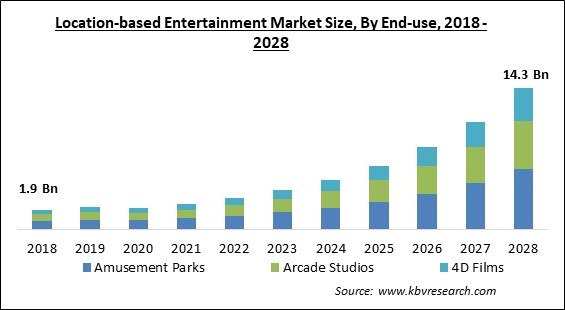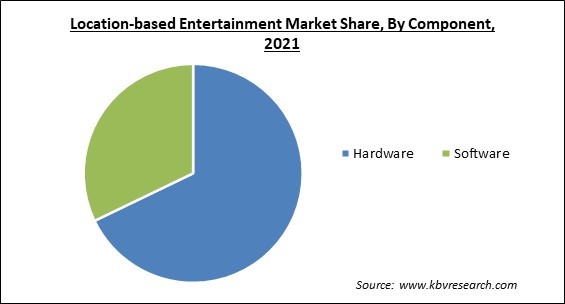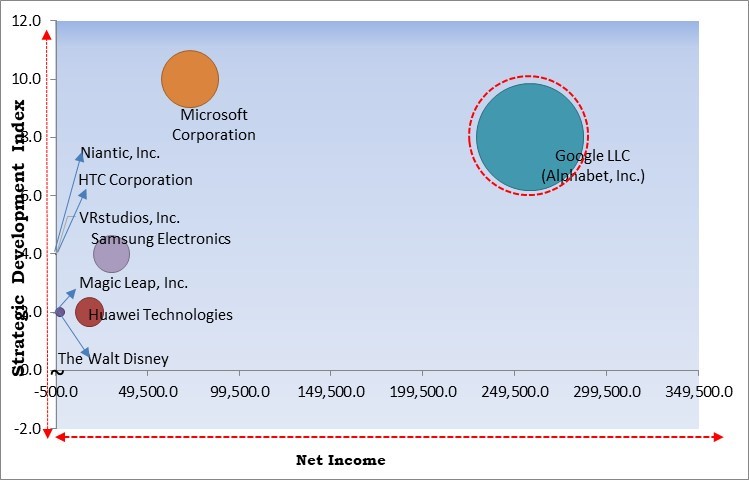The Global Location-based Entertainment Market size is expected to reach $14.3 billion by 2028, rising at a market growth of 28.5% CAGR during the forecast period.
Location-based entertainment is a destination that brings people together for a shared activity, whether friends, families, or caring brand communities eager to spend time together. It aims to connect individuals in real life so they may exchange experiences. Users using LBE may move around freely and engage physically with their surroundings, including genuine portable props or equipment. LBE enables in-person interaction and experience sharing amongst users.

Any entertainment connected to a specific place away from home is called LBE. The licensed and brand-owned physical experiences on the LBE market range from immersive cinema and theme parks to virtual reality cafés and pop-up shops. Location-based entertainment (LBE) is also known as interactive multiplayer entertainment centers or "out-of-home entertainment." LBE generally refers to any entertainment connected to a particular location outside the house.
Using the involvement axis and the technology axis, immersive LBE experiences may be further divided into these two categories. Instead of being a group of distinct types, these many axes make up a spectrum. The breadth of experiences includes anything from very fun to profoundly contemplative. Technology may also be a part of them in varied degrees, from fully analog to virtually entirely digital. For instance, a large entertainment complex or amusement park could provide experiences that fall in various spectrums.
Customers are looking for one-of-a-kind experiences that will compel them to leave their homes, learn something new, or just be amazed. Owners and operators of immersive LBEs must get a solid grasp of their target customers and markets to succeed. Ambitious providers should explore outside of their field and draw ideas from successful immersive LBEs across the board.
The market is likely to grow in the future years as limitations loosen and consumer demand for location-based leisure activities rises. Numerous leading LBE organizations used sophisticated analytics and data management to optimize consumer response to behavior patterns and demands. They invested much in location-based VR infrastructure and quality. VRstudios Sports, announced in September 2020, brings participants together in VR to interact, network, and share their experiences. VRstudios Sports' expanded LBE lets people play VR games at home.
VR game creation has serviced major markets worldwide and has tremendous potential. The Samsung Gear VR, Oculus VR, and HTC Vive have become popular as virtual reality technology has grown. Virtual reality gadgets with tracking, sensory, and hand controls make games fun and interactive. As a result, the number of VR gaming firms grew to meet demand. VR games let players feel the surroundings. Immersive visuals and 360-degree video content stimulate adrenaline. Players may customize the game environment using virtual reality controllers. VR improved shooters, simulations, and adventures. This supports the growth of the market.
AR/VR games are the most popular worldwide. Several game firms are exploring new technologies to better entertainment venue gaming. AR and VR are combined with 3D Projection-Mapping, interactive digital surfaces, and other technologies to create new gaming technologies. Family entertainment centers are upgrading their technology to provide more services via the internet and data instead of traditional games. Pure-play mapping software companies make projection mapping technologies to simplify project implementation and enhance audience watching. Consequently, the location-based entertainment market will grow due to the entertainment industry's mix of technology.

VR headsets may emit electromagnetic frequency radiation. These gadgets link to your smartphone or computer through Bluetooth or WiFi and include clever sensors to immerse you in VR. Smartphone-powered VR headsets produce radiation. Cell phone radiation may influence sleep, temperament, and the reproductive system. VR headsets may wirelessly connect to WiFi and interact with smartphones, emitting radiation and offering long-term health problems.
Based on the component, the Location-based Entertainment Market is divided into Hardware and Software. In 2021, the hardware sector had the largest revenue share. The development of VR/AR-based equipment, including headsets, haptic suits, and other simulation tools, is responsible for the increase. At the LBE facilities, VR-based hardware devices provide viewers an intense experience at a reasonable cost while giving them priceless memories. In particular, the growing use of low-cost VR headsets by LBE providers is encouraging for the expansion of the hardware market.
Based on the end-use, the Location-based Entertainment Market is divided into Amusement Parks, Arcade Studios, and 4D Films. In terms of revenue share, the arcade studios category led the market in 2021. Arcades' popularity is especially fueled by the cutting-edge functionality that allows for several VR experiences in one commercial environment. In many places with heavy foot traffic, such As cafés, restaurants, and bars, entertainment or gaming devices are becoming increasingly popular. Segment growth is anticipated to be fueled by game improvements that are made continually to draw in more players.
Based on the technology, the location-based entertainment market is divided into 2D, 3D, and Cloud Merged Reality (CMR). Due to ongoing technical improvements, the Cloud Merged Reality (CMR) market shows a promising growth rate throughout the projection period. Due to its time-saving benefits, CMR has been widely embraced by several big technology-based businesses. Also, the technology offers better usability and fewer data loss, encouraging its adoption by many companies in the gaming and entertainment industries.
| Report Attribute | Details |
|---|---|
| Market size value in 2021 | USD 2.6 Billion |
| Market size forecast in 2028 | USD 14.3 Billion |
| Base Year | 2021 |
| Historical Period | 2018 to 2020 |
| Forecast Period | 2022 to 2028 |
| Revenue Growth Rate | CAGR of 28.5% from 2022 to 2028 |
| Number of Pages | 213 |
| Number of Table | 343 |
| Report coverage | Market Trends, Revenue Estimation and Forecast, Segmentation Analysis, Regional and Country Breakdown, Competitive Landscape, Companies Strategic Developments, Company Profiling |
| Segments covered | Component, Technology, End-use, Region |
| Country scope | US, Canada, Mexico, Germany, UK, France, Russia, Spain, Italy, China, Japan, India, South Korea, Singapore, Malaysia, Brazil, Argentina, UAE, Saudi Arabia, South Africa, Nigeria |
| Growth Drivers |
|
| Restraints |
|
Based on the geography, the Location-based Entertainment Market is divided into North America, Europe, Asia Pacific, and LAMEA. Due to rising consumer preference for outdoor leisure activities over other forms of entertainment, Asia Pacific is predicted to see significant CAGR throughout the projected decade. Also, the area is home to several international VR hardware and software vendors, opening up significant market potential. China announced the inauguration of its first theme park outfitted with cutting-edge technology in January 2021.
Free Valuable Insights: Global Location-based Entertainment Market size to reach USD 14.3 Billion by 2028

The major strategies followed by the market participants are Partnerships. Based on the Analysis presented in the Cardinal matrix; Google LLC is the forerunner in the Location-based Entertainment Market. Companies such as Microsoft Corporation, Samsung Electronics Co., Ltd., and Huawei Technologies Co., Ltd. are some of the key innovators in Location-based Entertainment Market.
The market research report covers the analysis of key stake holders of the market. Key companies profiled in the report include The Walt Disney Company, Google LLC (Alphabet, Inc.), HTC Corporation, Huawei Technologies Co., Ltd. (Huawei Investment & Holding Co., Ltd.), Magic Leap, Inc., Microsoft Corporation, Samsung Electronics Co., Ltd. (Samsung Group), Niantic, Inc., VRstudios, Inc. (FOD Capital, LLC), and KidZania S.A.P.I. de C.V.
By Technology
By Component
By End-use
By Geography
The global Location-based Entertainment Market size is expected to reach $14.3 billion by 2028.
AR/VR and 3d projection mapping would increase demand are driving the market in coming years, however, Health hazards of extensive VR headset use restraints the growth of the market.
The Walt Disney Company, Google LLC (Alphabet, Inc.), HTC Corporation, Huawei Technologies Co., Ltd. (Huawei Investment & Holding Co., Ltd.), Magic Leap, Inc., Microsoft Corporation, Samsung Electronics Co., Ltd. (Samsung Group), Niantic, Inc., VRstudios, Inc. (FOD Capital, LLC), and KidZania S.A.P.I. de C.V.
The 3-Dimensional (3D) segment acquired maximum revenue share in the Global Location-based Entertainment Market by Technology in 2021 thereby, achieving a market value of $6.4 billion by 2028.
The Amusement Parks segment is leading the Global Location-based Entertainment Market by End-use in 2021 thereby, achieving a market value of $6.1 billion by 2028.
The North America market dominated the Global Location-based Entertainment Market by Region in 2021, and would continue to be a dominant market till 2028; thereby, achieving a market value of $5.1 billion by 2028.
Our team of dedicated experts can provide you with attractive expansion opportunities for your business.

